How to cut a Pomeranian?
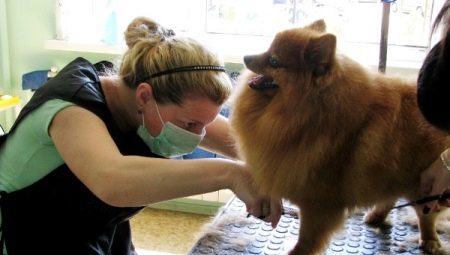
The most important feature of the Spitz is their adorable toy appearance. And, of course, a lush, thick coat, which makes them look like little bears, or very fluffy chanterelles. But as soon as the state of this "coat" is started at least a little, the dog's cuteness goes away. In order for the fluffy to always remain neat, neat, he just needs a regular haircut.
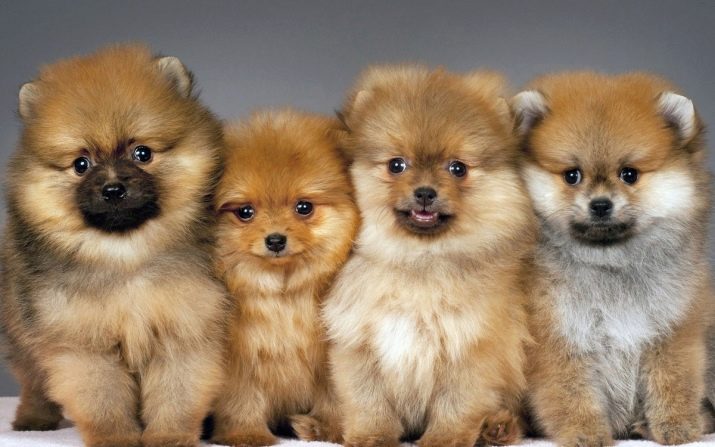
Is grooming necessary?
Grooming is a haircut, but more precisely, it is aesthetic care for the appearance of a dog.... If you have acquired a dog of this breed, you will have to come to terms with this point of spending. To make your little joy look like a teddy bear with black button eyes and a beautiful collar, the dog should regularly visit the groomer.
The owner himself must comb the pet out - once a week, steadily. If you do this more often, you can harm the dog: he will lose most of the undercoat. This will cause the Spitz to become smooth due to the fall of the guard hair. It also happens that due to frequent combing, the dog forms real bald spots.

Attention! Ears, crotches and armpits deserve special attention regarding combing. Here tangles can most often form.
A fluffy haircut is usually needed every two to three months. After such an update, the baby looks like a doggie from an advertisement: his coat is even, smooth, well-groomed. A groomer can only cut the ends of the coat, which is fine too, or can give a fluffy client a real model haircut.
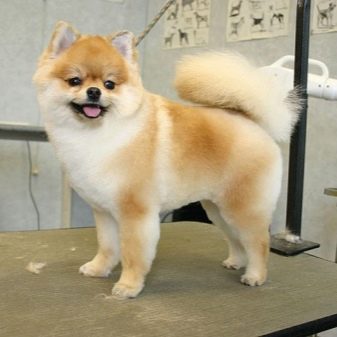
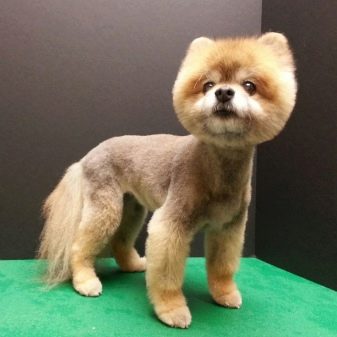
Coat structure
Up to three months, the puppy's body is covered with very thin hairs, which more resemble fluff. But the same adult fluffy coat, for which the Pomeranian is known, is formed only by 3.5 months. The dog's fur will finally change by the year.
Spitz coat is presented:
- guard hair - This is a hard and straight coat that stands perpendicular to the dog's body;
- undercoat - soft spiral long hairs that make up the bulk of the coat.
The most "woolen" places in a Spitz are the collar, tail and hind legs. To keep the baby's fur in order, as already mentioned, the dog needs to be combed out regularly (once or twice a week). You do not need to contact a specialist every time - it is enough to purchase a minimum set of tools so that the trimmed Pomeranian looks neat.
These tools are: massage comb, slicker brush, comb. You can even take a regular massage intended for a person. Her teeth should be long, 3 cm. With such a comb, you can unravel the fur until the speech comes to the slicker, it is also convenient for drying the fur with a hairdryer.
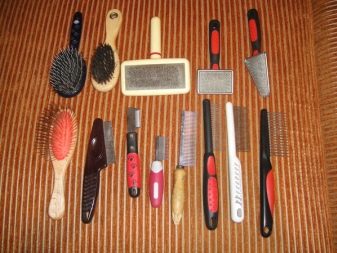
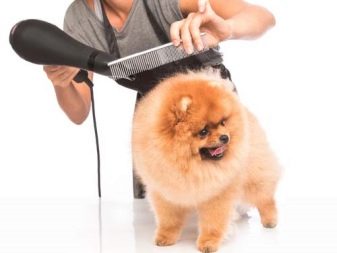
Get a slicker with moderate hardness and long teeth. There should be no plastic curves at the tips of the teeth.
Comb through the hair from roots to ends, dividing it into partings. At the time of molting, the slicker becomes simply an irreplaceable tool.
The comb is needed to raise the hairs, to give the fur extra volume. Finally, it is convenient to use it to clean out the remaining hairs. The groomer must use a comb when clipping a Pomeranian.
Types of haircuts
It is easier and more reliable to cut a Pomeranian Spitz in a grooming salon, but if you have certain skills, you can do it at home. Even before cutting, the Spitz needs to be combed and washed.
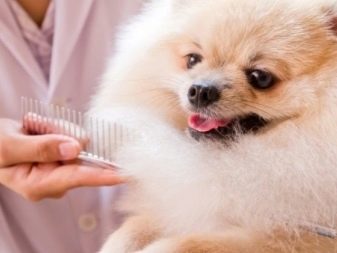
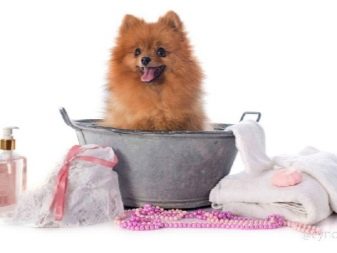
There are four of the most popular types of haircuts.
- Exhibition (classic). This is how they usually decorate, put in order the dog on the eve of the exhibition. The animal is cut so that the update is not striking for the experts, but at the same time, so that all the advantages of the dog are in sight, and the shortcomings are hidden. Thinning scissors shape the ears of the Spitz. Excess hairs from the ear canal also have to be removed. The groomer gives the paws a soft, or, as it is also called, feline, shape. All excess hairs along the contour of the fingers are also removed.
The collar and tail need to be made more magnificent so that they are spherical. This is also achieved through thinning. The area under the ponytail is trimmed last.
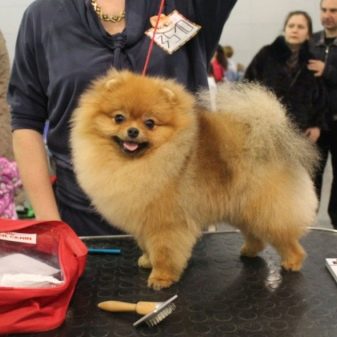
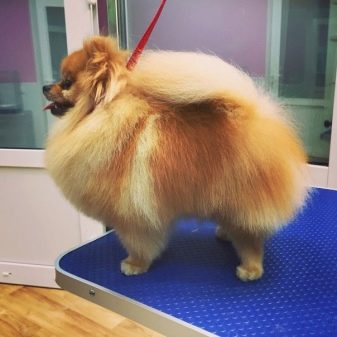
- Under the teddy bear. Otherwise, this haircut is called "under Boo." Boo is a dwarf spitz who, ten years ago, became the star of Facebook and the entire Internet. It looked a lot like a plush toy, and soon Boo had a lot of imitators. The boo / teddy bear haircut is distinguished by the following: round head (ears on the same level with the nape), short hair on the body (of the same length), short hair on the paws (for roundness of the shape). As a result, the doggie will turn out to be a poured teddy bear. But only with such a cute haircut a Spitz cannot participate in competitions.
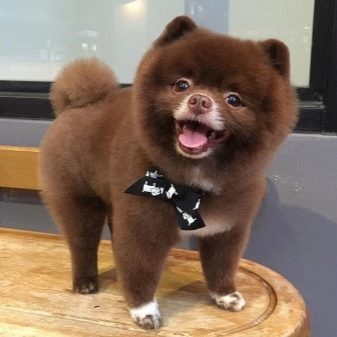
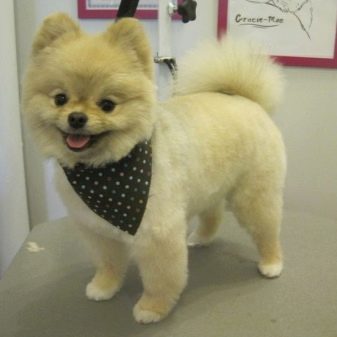
- Modern. The difference between this haircut and the exhibition one is that the silhouette of such a "hairstyle" is worked out more carefully. The kid is even more cute and neat, but does not lose its breed appearance. The main thing is that an experienced groomer should do the haircut, because a well-filled hand is very important in modern style.
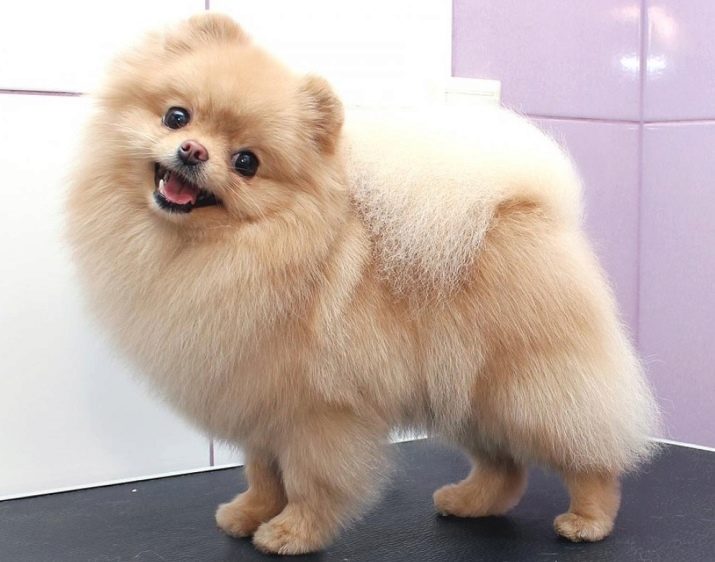
- A lion. The name speaks for itself. With the help of such a haircut from a Spitz, you can make a "pocket" lion. Excess fur is trimmed with a machine, leaving what resembles a lush mane. Be sure to leave a brush at the tip of the tail. The fur is given a special volume with the help of the same thinning scissors.
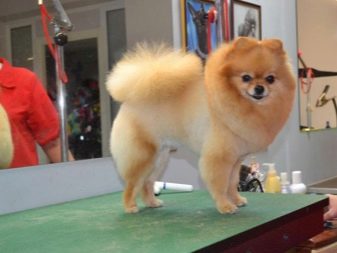

But the last option is still the most undesirable. It is believed that all lovers of such a haircut run the risk of bringing their pet to baldness.
How often should I cut my dog?
As already noted, the Miniature Spitz should visit the groomer once every 2-3 months. But this should be a planned visit, and not another reason for an experiment on a dog, which the owner will rejoice at. Alas, not all breeders treat the task assigned to them with understanding and responsibility. Often they perceive the Spitz as a cute accessory that needs to be updated from time to time, for example, with a new haircut.

The danger is that some owners are sure - there are a lot of fluffy Spitz, I will cut mine short. But this breed cannot be cut short! You can remove the undercoat while shaving to harm your pet. Finally, the skin of this little dog is thin and sensitive, therefore the thick, rather long, wool inherited from nature is for the Spitz a natural defense against various kinds of damage, insect bites, and climatic influences.
And if the air temperature drops sharply, then a short-cropped doggie can easily get sick. Those who cut their Pomeranian short should at least buy protective coveralls for them.
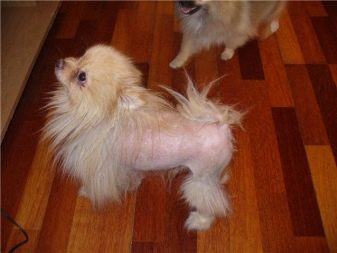
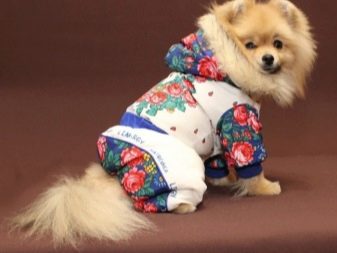
Finally, the question of the exhibition. If the experts see on it that the dog has recently been trimmed, you will lose all chances of success. According to the regulations, the doggie should look natural. Many owners carry out grooming no later than six months before the show. White Spitz, brown or any other - this aspect does not matter.
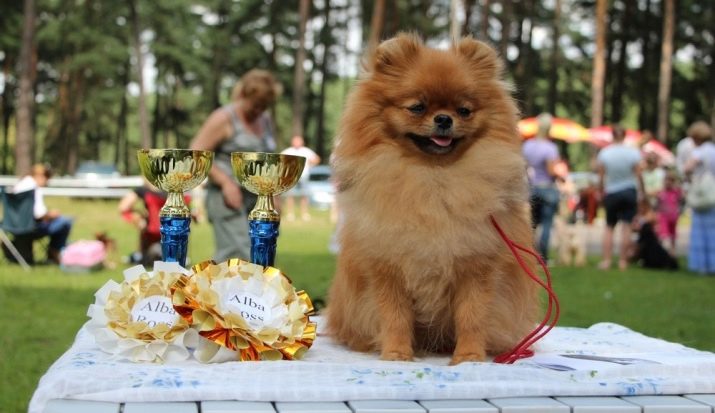
The subtleties of the procedure
What is the correct way, taking into account all the nuances, to cut a Spitz? The technique is known, but first you need to make a choice, whether you will cut it in the salon, or still limit yourself to cutting the "fur coat" at home.
In salons
If you are not proficient in grooming, take your pet to a professional. Groomers will do everything quickly, efficiently, and your baby will leave the salon clean, tidy and prettiest.
The foreman often starts working from hard-to-reach areas. First, the legs are carefully processed. The fur between the fingers is very carefully examined, all excess hairs are removed. The master does it with thin scissors. Then the specialist, as a rule, trims the "pants" on the legs. It is enough to process them with a typewriter.
Next, the master goes to the wool at the base of the tail. Then the ears are processed. They are cut very neatly, because their fur is very short. One awkward movement and you can hurt the dog. After the ears, the intimate area of the dog is processed. Near the anus, the fur is cut short - this is not an aesthetic goal, but a hygienic one.
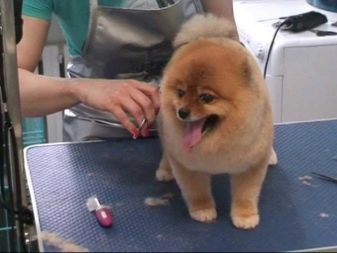
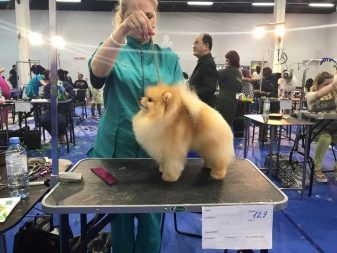
After a haircut, the groomer combes the pet again, smoothes his fur, removes what he cut.
At home
For home grooming, you will need tools. And there are not so few of them.
For a haircut you need:
- scissors of different lengths with safety tips;
- metal combs;
- soft-bristled massage brushes;
- slicker;
- furminator for combing out the undercoat;
- cosmetics for dogs: shampoo, balm, etc .;
- nail clipper (can be used by a cat);
- hairdryer;
- hair clipper;
- potassium permanganate (needed in case of a cut, it can be replaced with special antiseptic powders from pharmacies).
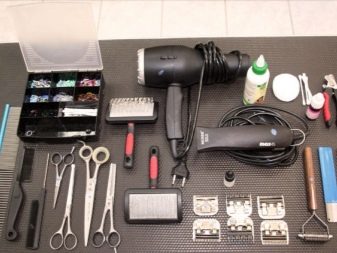
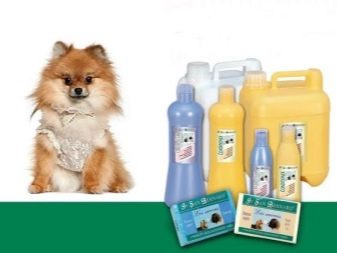
Of course, the first time you need to cut a doggie is in the salon. It makes sense for the owner to observe how the master works, and to "wind up". Then a home haircut will not be carried out purely on a theoretical basis.
Big questions from the owners of pomeranians arise regarding the haircut of the baby with a typewriter. But everything is not so complicated here. You need to take the largest nozzle, pre-process hard-to-reach places with scissors (ears and paws first). The area under the tail also needs to be cut with scissors. But the body, "pants" and the tail are processed with a typewriter. The electric tool should be carefully guided down the growth of the coat.
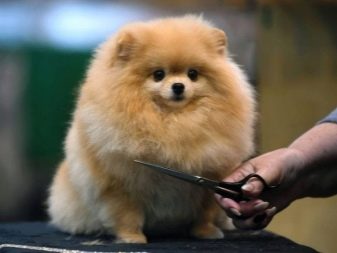
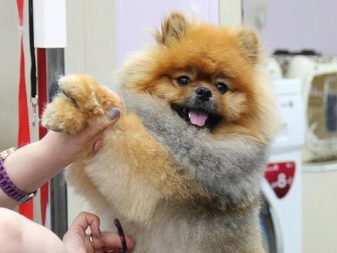
Whether you want to trim your baby for the show or just give him a classic look, the end result should be:
- the dog looks round after a haircut;
- the dog's ears do not stick out on the head, but merge with the contour of the head;
- there are no hairs knocking out along the contour;
- the paws have even feathers, and the toes are trimmed according to the principle of a cat's paw;
- the tail is located on the back in a fan, the tip of the tail reaches the head.
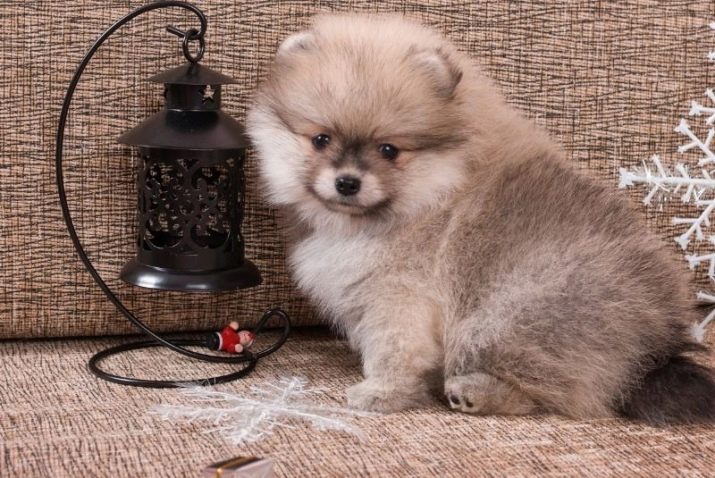
But to cut a doggy "like a bear cub" at home is a risky business. It also happens that the dog's cover is not restored. Again, if you cut your Pomeranian "under Boo", and then decide to participate in the competition, you will have to wait a very long time for regrowth.
Recommendations for choosing a groomer
The professionalism of the master is always important, in any business. And if you love your pet, I would like that his paws and all of him fall into the hands of an experienced, talented groomer.
There are 5 criteria for choosing the best groomer.
- Reviews. Of course, word of mouth is still alive. And it often gives the most accurate clues.
- Knowledge of the breed. A good groomer can hand-cut dogs of a wide variety of breeds, although a narrow specialization also has a place to be. If a specialist practically does not cut Pomeranians, why would you make your pet an object for an experiment? It is better to go further, pay a little more, but trust a specialist who is deeply "in the subject."
- Instruments. Take a look at the tools the wizard works with. They must be neat, orderly, kept clean. If the scissors are rusted, the table is wobbling, and after the previous client the workplace is not cleaned, is it worth trusting such a master?
- Contact. It is very important to detect contact between the master and the pet. If the baby is scared, if he literally trembles in the hands of a specialist, and he does not try to calm him down, cheer him up, the haircut is unlikely to be successful, and the baby will be afraid of the procedure next time. If the groomer is rude to the animal, an urgent need to rescue the pet, it makes sense to declare what he saw to the management of the organization.
- Mastery in professional growth. If a grooming master is trying, advancing in his business, evidence of this, most likely, you will observe in diplomas, certificates, participation in a professional skill competition, etc. This is always a plus for a specialist.
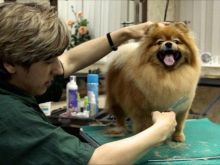
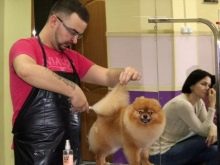
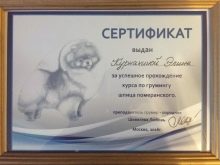
Finally, the professional look of the groomer is important. He must take into account both your request and his own vision.
If a client wants a conditionally extreme haircut, but the master understands that it can harm the dog, he must be sure to delicately tell the client about it.
Take care of your fluffy pet, cut it in a timely manner, without disturbing the structure of the fur and not forcing the dog to freeze. A dog, whatever breed it is, is a responsibility. If the owner remembers this, his pet will be full, satisfied, neat and happy like a dog.

See the following video for grooming a Pomeranian.






































